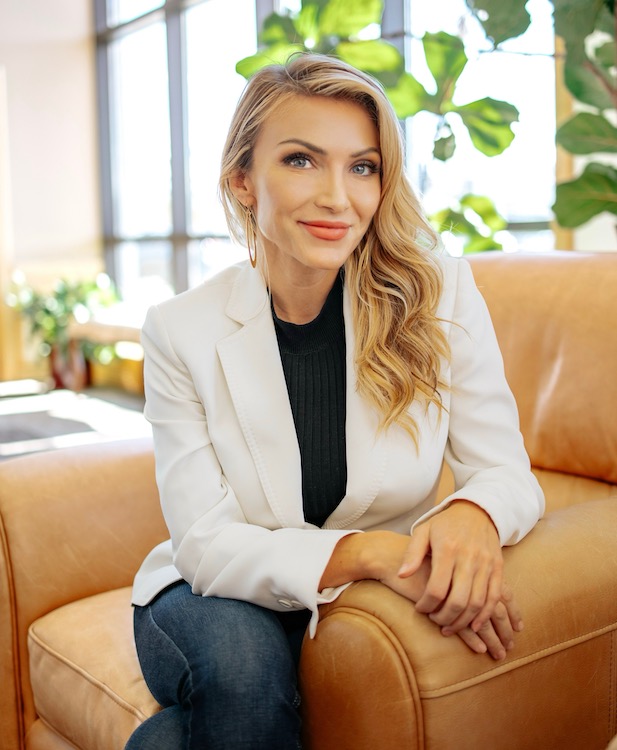
PR 101

Public relations guru Sarah Pettit offers insider tips learned over the years
by Sarah Pettit (’11)
I have been working at Associated Food Stores, a grocery coop that assists local mom-and-pop grocers that compete with national retail chains, for 11 years. I wear many hats, and my skills cover public and media relations, crisis communications, public affairs, creative direction, and marketing for our exclusive brands. Throughout my career, I have learned a few things that came through hard knocks and wonderful tips from colleagues.
Here are lessons learned from three experiences not included in my textbooks from which others in our field may benefit. After all, once a Griffin, always a Griffin.
One major media outlet will likely lead to others. During the height of the pandemic, when grocery stores were experiencing supply shortages across the nation, I wanted to communicate that our supply chain was still flowing to calm panic buying. I encountered a photographer from the Associated Press and took him on a tour of our warehouse with the Deseret News. Within two weeks of his photos being published, I heard from CNN, The Wall Street Journal, and Good Morning America. One home run truly leads to another, and if you get picked up by one major outlet, more are likely to come. Receiving publicity on Good Morning America felt somewhat like winning the Super Bowl of PR. Reaching this milestone was a reminder that working hard and nurturing connections truly pay off.
If you cannot find the name of a reporter, there’s a reason. Early in my career, I was approached by a local news station that wanted to do a story on weights, measures, and scanning and how they worked. Prior to agreeing to the coverage, I scoured the internet and my database looking for the name of the reporter. I came up empty-handed. I was assured that he had only been in the Salt Lake market a short while. Knowing that we have an impressive and incredibly accurate scanning team, I spoke with our executives, and we agreed to the story.
Filming went well. However, I was surprised to later learn that the story aired under an investigative segment. The reporters revealed that they could not find any challenges while at our location, and the larger story ended up being about the process of weights and measures.
This experience taught me that if you can’t find a reporter’s name online, they likely don’t want you to find it. The number one role of PR is to protect your client’s reputation. I knew our scanning team was 100 percent accurate, or I would have never accepted the interview. Because of my confidence in our team, I was able to change the narrative from a potentially negative story to one that promoted trust in our brand. That said, if we had been off, the story would have demonstrated that retailers struggle to match prices with the tags on the shelf, which would have resulted in a negative story. My takeaway? Don’t be afraid to ask questions. If you can’t find the reporter’s name, specifically ask what segment the story is airing under.
Always be prepared to talk about … anything. I brought an executive to speak at a press conference for a local charitable event we were kicking off. While I was talking to one reporter, another reporter pulled my executive aside and started an interview. She began grilling him with questions that had nothing to do with the event we were attending. My executive was ready and answered the questions thoughtfully. After the third question, I asked the reporter if she had any questions regarding the event we were there to promote. She said “No.” I thanked her for her time, closed the interview, and said she could reach out to talk about other topics—and I would be happy to accommodate.
This experience is a testament to fully preparing spokespersons to talk about a variety of topics. When you are meeting with members of the media, they can ask your spokespersons about anything. Your PR professional should also be on hand to protect your brand by monitoring the interview—and should not hesitate to limit or end the interview if necessary. Thoughtfully consider who should be on camera, can handle tough questions without becoming defensive or nervous, and can answer questions transparently with your company values in mind. Never forget that reporters consider themselves watchdogs for the public—and they’re always looking for the best story possible.
About the Westminster Review
The Westminster Review is Westminster University’s bi-annual alumni magazine that is distributed to alumni and community members. Each issue aims to keep alumni updated on campus current events and highlights the accomplishments of current students, professors, and Westminster alum.
GET THE REVIEW IN PRINT Share Your Story Idea READ MORE WESTMINSTER STORIES